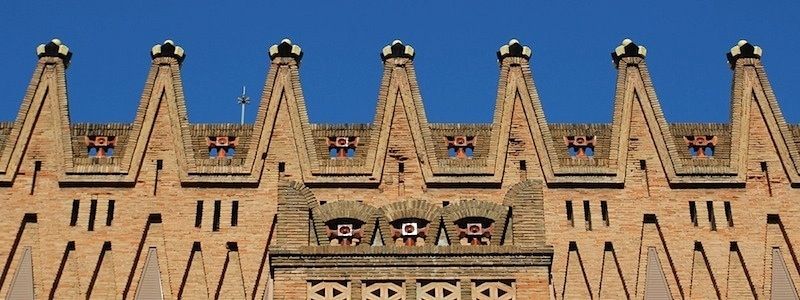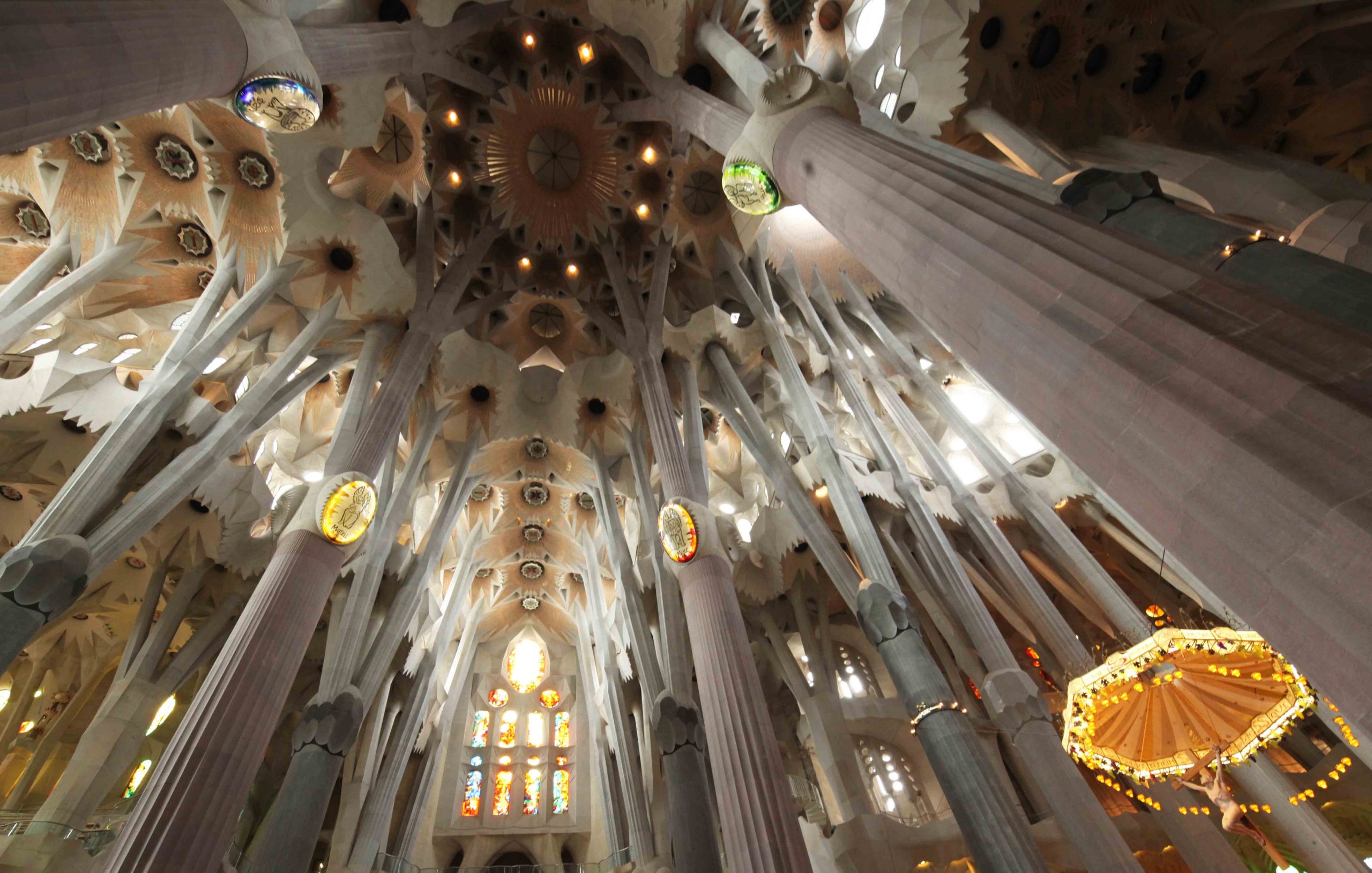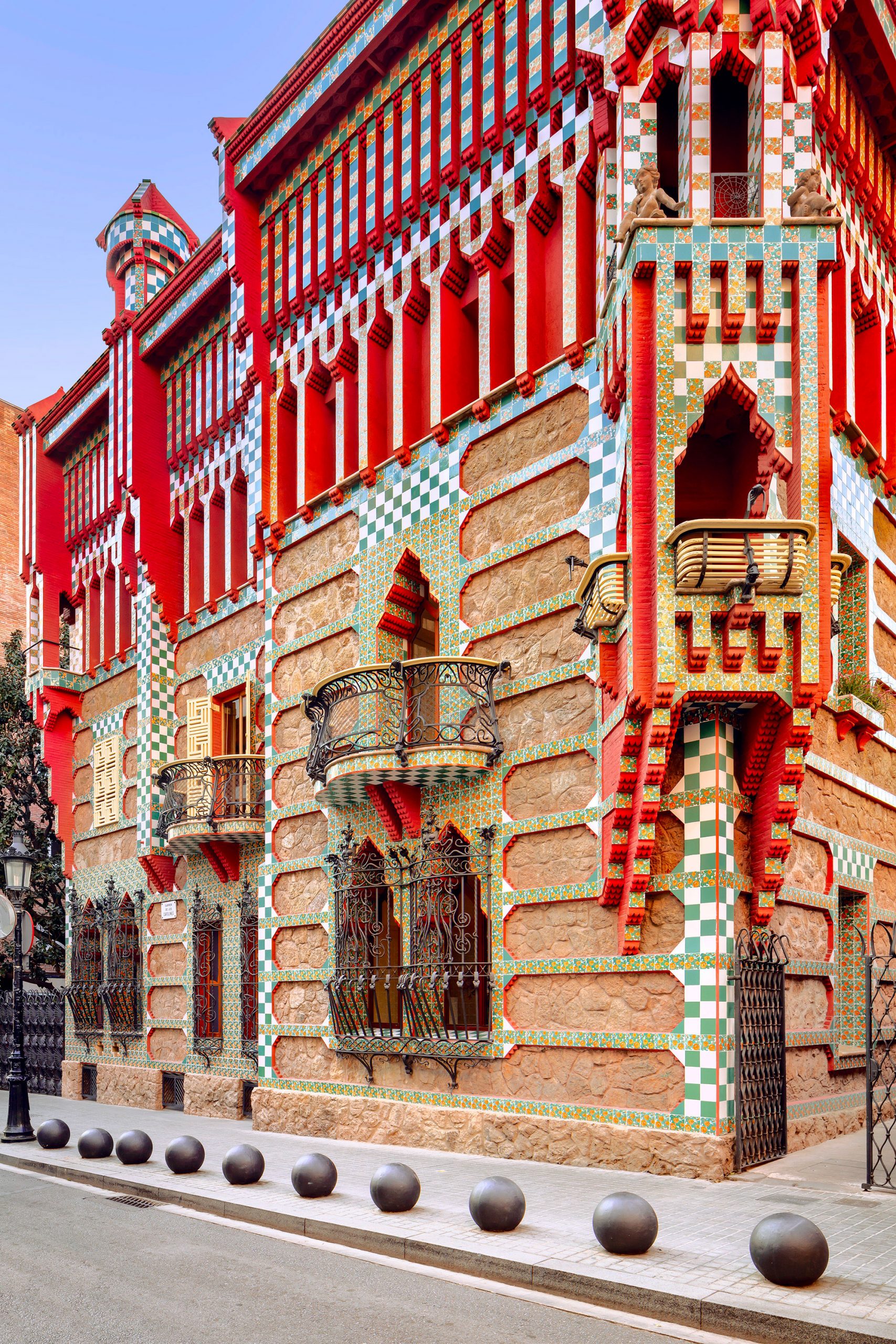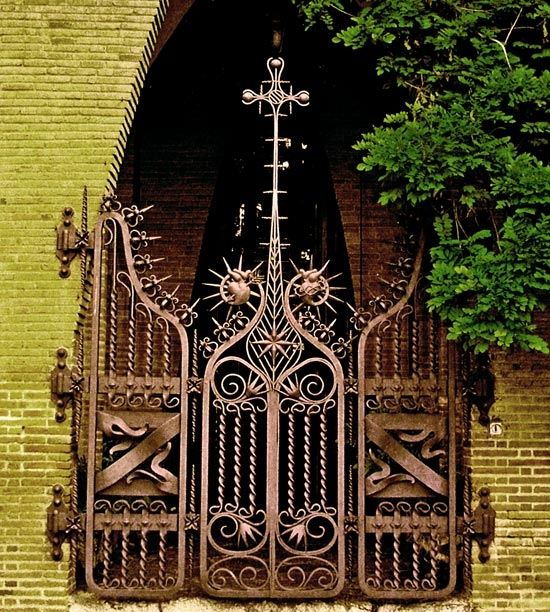Antoni Plàcid Guillem Gaudí i Cornet
The Teresian School Source: http://paraviajarproject.blogspot.com/2016/03/barcelona-nick-j.html
During the second half of the 19th century, Barcelona was at its economical and social peak. The old part of the city, surrounded by walls and bounded by the sea, had become too small to accommodate the large buildings that were being put up by the new emerging society. In 1857 a decision was taken to annex neighbouring towns, which until then had been summer destinations where the middle class had constructed enormous mansions that still stand today.
Casa Vincens Source: https://www.thisiscolossal.com/2019/06/casa-vicens/
1878 marks the beginnings of Modernism in Spain when Catalan architect Domenech i Montaner published an article in the Catalan newspaper La Renaixensa entitled “The Quest for a National Architecture” where he expressed the need for Catalonia to develop its own individual style. From that moment on, buildings were constructed based on history yet characterized by the personality of the architect who transformed classical notions into new architectural interpretations. Casa Vincens (1878-1880), designed by Antoni Gaudí, is an example of this movement.
If indeed the year of 1878 was key, it was not until 1880 that the Modernist style came into its own. The 1888 Universal Exhibition held in Barcelona provided a platform for promoting and exhibiting the artistic novelties that would not take long to spread throughout society as a whole.
The Barcelona Exhibition served to demonstrate the power of the middle class, who believed they were fulfilling the dream of modernization thanks to the economic prosperity they had attained. After the Exhibition, the nobility and especially the middle class wanted to move to the Eixample, the new urban development space created by tearing down the walls of the city in order to gain more space, where they would take residence and commission the construction of spectacular works of architecture.
Due to the socio-political conditions in Catalonia between the end of the 19th century and the beginning of the 20th century the Moderniste movement reached level unlike anywhere else in Spain. Notwithstanding, it would be an error to assume that Modernism solely took place in Catalonia, as it also played an important and varied role in Spanish cities a Madrid, Valencia, Zaragoza and Melilla, among others.
The Teresian College Source: https://www.skyscrapercity.com/threads/mijn-gaudi-tour.1454769/#post-85122212
Casa Mila. Source: Source: https://www.barcelo.com/guia-turismo/en/barcelona/things-to-do/casa-mila/
Since 1906 Eugeni d’Ors, Catalan writer, essayist, journalist, philosopher and art critic, pioneered the term Noucentism through publication of a collection of writings published between 1907 and 1911 that set the aesthetic and cultural ideals advocated by the new movement, characterized by an adamant rejection of anything related to Modernisme. Despite these dates, however, Modernisme cannot be placed within an exact time period given that works displaying a distinct Modernista style continued to be built after 1906, including Antoni Gaudí renowned Casa Milá.
In this artistic milieu was Antoni Gaudí born in Reus, Tarragona, Spain in 1852. Son of a working-class family, he manifested his passion for art from a very young age. In 1873 he began his architectural studies at the Barcelona School of Architecture. The need for financial means to pay for his studies led him to work as a drafts in various workshops. Through his years as a student, Gaudi executed a number of designs and worked with renowned architects such as Francesc de Paula del Villar whom he aided in designing the sanctum and apse of the Montserrat monastery. He finished his architectural education in Madrid, finishing his studies in 1876. From then on he would design and build a vast number of works. Ever since his early years as a professional he demonstrated the attributes of a well-rounded artist. His are works as diverse as lamppost in Barcelona, furniture design, wrought iron, wood and glass display cabinets for gloves in the Paris Exhibition and a flower stand.
Teresian School Entrance. Source: http://www.gaudidesigner.com/es/autres-realisations-colegio-de-las-teresianas-1888-1890—barcelona—a.gaudi_575.html
Episcopal Palace, Astorga. Source: https://astorga.co/en/episcopal-palace-of-astorga-by-gaudi/
Gaudí’s extravagant style was surprisingly well received by Catalan society. In fact the architect undertook commissions for the Catalan bourgeoisie (Vincens, Calvet, Batlló and Milá and in some cases recently ennobled families such as the Güellls) who accepted his creations with a certain stoicism, as did the masses of Chistian devotees in their support of the colossal Sagrada Familia temple in Barcelona. It is also surprising that some of his commissions would take Gaudí to places so distant from his Catalan personality deep into Spain, such as Comillas (Santander). Leon or Astorga. However, they all had some sort of Catalan connection; in Astorga, for instance, the project was commissioned by the Catalan bishop that presided over the diocese of Leon.

The Terisian College, Gaudis first major work. Source: https://irbarcelona.org/barcelona-famous-buildings/collegi-teresianes/
Antoni Gaudí who always practised his profession independently and never worked as a public servant, never received any awards or honors by any academy, nor did he participate in any political organization. He was a magnificent artist, unclassifiable and always astonishing who exercised his craft with an extreme precision, a result of a fevered imagination. It is the result of this imagination that, even today, almost 100 years after his death, he continues to be regarded as one of the main attraction of Barcelona, the city that contains the most and best examples of Antoni Gaudí’s spectacular and creative work.

Casa Batlló. Source: https://www.timeout.com/barcelona/art/gaudi-barcelona-nine-of-the-architects-greatest-hits
Not given to writing about his esthetic preferences, he is known to have published only one article in 1881. During the late 1870s he met Eusebi Güell, who over the years would become his perfect patron, giving him total freedom in designing and executing the projects he was commissioned. Gaudi’s connection with both the bourgeoisie and the Catholic Church were of paramount importance for his long career, whose major masterpieces are a reflection of those relationships. His religious education and close friendship with clergymen and bishops from various cities helped create an impeccable Christian image of him.
In 1882, the first stone of the Sagrada Familia temple was laid. At that time, the young Gaudi was not yet associated with the project, although one year later he was commissioned to perform a study of the columns in the crypt. The first author of the project was Francesc de Paula del Villar, Gaudi’s teacher in the School of Architecture. Del Villar supervised the construction as far as the capitals of the crypt, after which abandoned the post due to a disagreement with the foreman over technical aspects of the project. On 3 November 1883 Gaudi was named the new supervisor of the construction of the Sagrada Familia. The young architect was barely thirty years old and would stay with this project until the end of his life.
The temple, when finished, will have 18 bell towers: one representing Christ, one for the Virgin Mary, four for the evangelists and 12 for the apostles.
Antoni Gaudí who always practised his profession independently and never worked as a public servant, never received any awards or honors by any academy, nor did he participate in any political organization. He was a magnificent artist, unclassifiable and always astonishing who exercised his craft with an extreme precision, a result of a fevered imagination. It is the result of this imagination that, even today, more than 100 years after his death, it continues to be regarded as one of the main attraction of Barcelona, the city that contains the most and best examples of Antoni Gaudí’s spectacular and creative work. Gaudí rarely drew detailed plans of his works, instead preferring to create them as three-dimensional scale models and moulding the details as he conceived them.

Inside the Sagrada Familia. Source: https://www.atlasobscura.com/places/sagrada-familia

Citations
- Isabel Artigas. Gaudi. Complete Works, vol.1&2, Taschen GmbH, 2007
- Encyclopedia Britannica vol.10 ‘Gaudi, Antonio’
- Roe, J. Antoni Gaudi, – Parkstone International – New York, 2012






